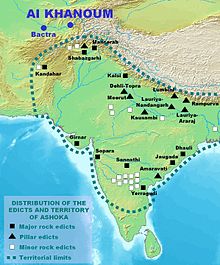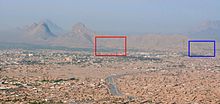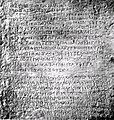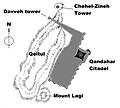Kandahar Greek Edicts of Ashoka
| Kandahar Greek Edicts of Ashoka | |
|---|---|
 Greek inscription by king Ashoka, discovered in Kandahar | |
| Material | Sandstone tablet |
| Size | 45x69.5 cm |
| Writing | Greek |
| Created | circa 258 BCE |
| Period/culture | 3rd Century BCE |
| Discovered | 31°36′09N 65°39′32E |
| Place | Old Kandahar, Kandahar, Afghanistan |

The Kandahar Greek Edicts of Ashoka are among the Major Rock Edicts of the Indian Emperor Ashoka (reigned 269-233 BCE), which were written in the Greek language and Prakrit language. They were found in the ancient area of Old Kandahar (known as Zor Shar in Pashto, or Shahr-i-Kona in Farsi) in Kandahar in 1963.[1] It is thought that Old Kandahar was founded in the 4th century BCE by Alexander the Great, who gave it the Ancient Greek name Ἀλεξάνδρεια Ἀραχωσίας (Alexandria of Arachosia).
The extant edicts are found in a plaque of limestone, which probably had belonged to a building, and its size is 45x69.5 cm and it is about 12 cm thick. These are the only Ashoka inscriptions thought to have belonged to a stone building.[1][2] The beginning and the end of the fragment are lacking, which suggests the inscription was original significantly longer, and may have included all 14 of Ashoka's Edicts in Greek, as in several other locations in India.[2] The plaque with the inscription was bought in the Kandahar market by the German doctor Seyring, and French archaeologists found that it had been excavated in Old Kandahar. The plaque was then offered to the Kabul Museum,[3] but its current location is unknown following the looting of the museum in 1992–1994.[4]
Background[]
Greek communities lived in the northwest of the Mauryan empire, currently in Pakistan, notably ancient Gandhara near the current Pakistani capital of Islamabad and in the region of Gedrosia, and presently in Southern Afghanistan, following the conquest and the colonization efforts of Alexander the Great around 323 BCE. These communities therefore were significant in the area of Afghanistan during the reign of Ashoka.[5]
Content[]


The Edict is a Greek version of the end of the 12th Edicts (which describes moral precepts) and the beginning of the 13th Edict (which describes the King's remorse and conversion after the war in Kalinga), which makes it a portion of a Major Rock Edict.[6] This inscription does not use another language in parallel, contrary to the famous Kandahar Bilingual Rock Inscription in Greek language and Aramaic, discovered in the same general area.[7]
The Greek language used in the inscription is of a very high level and displays philosophical refinement. It also displays an in-depth understanding of the political language of the Hellenic world in the 3rd century BCE. This suggests the presence of a highly cultured Greek presence in Kandahar at that time.[2]
Implications[]
The proclamation of this edict in Kandahar is usually taken as proof that Ashoka had control over that part of Afghanistan, presumably after Seleucus I had ceded this territory to Chandragupta Maurya in their 305 BCE peace agreement.[1] The Edict also shows the presence of a sizable Greek population in the area[5][8] where great efforts were made to convert them to Buddhism.[9] At the same epoch, the Greeks were established in the Greco-Bactrian kingdom, and particularly in the border city of Ai-Khanoum, in the northern part of Afghanistan.
Translation[]
| English translation | Original Greek text |
|---|---|
|
|
Other inscriptions in Greek in Kandahar[]

The Kandahar Bilingual Rock Inscription, discovered in 1958, is the other well-known Greek inscription by Ashoka in the area of Kandahar. It was found on the mountainside of the Chil Zena outcrop on the western side of the city of Kandahar.
Two other inscriptions in Greek are known at Kandahar. One is a dedication by a Greek man who names himself "son of Aristonax" (3rd century BCE). The other is an elegiac composition by Sophytos son of Naratos (2nd century BCE).[12]

Kandahar Bilingual Rock Inscription in Greek and Aramaic, by Emperor Ashoka, 3rd century BCE, Kandahar.

Inscription in Greek by the "son of Aristonax", 3rd century BCE, Kandahar.

Kandahar Sophytos Inscription, 2nd century BCE, Kandahar.

Plan of ancient fortifications of Kandahar.
See also[]
- Edicts of Ashoka
- Gandharan Buddhism
- Greco-Buddhism
- Indo-Greek Kingdom
- Kandahar Bilingual Rock Inscription
- List of Edicts of Ashoka
- Pillars of Ashoka
References[]
- ^ Jump up to: a b c Dupree, L. (2014). Afghanistan. Princeton University Press. p. 287. ISBN 9781400858910. Retrieved 2016-11-27.
- ^ Jump up to: a b c Une nouvelle inscription grecque d'Açoka, Schlumberger, Daniel, Comptes rendus des séances de l'Académie des Inscriptions et Belles-Lettres Année 1964 Volume 108 Numéro 1 pp. 126-140 [1]
- ^ "Kabul Museum p.9" (PDF). Archived from the original (PDF) on 2016-11-28. Retrieved 2016-11-29.
- ^ Archaeology "Museum Under Siege" April 20, 1998
- ^ Jump up to: a b c Dupree, L. (2014). Afghanistan. Princeton University Press. p. 286. ISBN 9781400858910. Retrieved 2016-11-27.
- ^ Asoka, Romilla Thapar
- ^ Rome, the Greek World, and the East: Volume 1: The Roman Republic and the Augustan Revolution, Fergus Millar, Univ of North Carolina Press, 2003, p.45 [2]
- ^ Indian Hist (Opt). McGraw-Hill Education (India) Pvt Limited. 2006. p. 1:183. ISBN 9780070635777. Retrieved 2016-11-27.
- ^ Halkias, G. (2014), When the Greeks Converted The Buddha: Asymmetrical Transfers of Knowledge in Indo-Greek CulturesLeiden: Brill, pp. 65-116 [3]
- ^ "Afghanistan", Louis Dupree, Princeton University Press, 2014, p.286
- ^ Schlumberger, Daniel (1964). "Une nouvelle inscription grecque d'Açoka". Comptes rendus des séances de l'Académie des Inscriptions et Belles-Lettres (in French). 108ᵉ année, N. 1: 131. doi:10.3406/crai.1964.11695. Retrieved 25 September 2018.
- ^ The Oxford Handbook of Ancient Greek Religion, Esther Eidinow, Julia Kindt, Oxford University Press, 2015
Coordinates: 31°36′09″N 65°39′32″E / 31.60250°N 65.65889°E
| Edicts of Ashoka (Ruled 269–232 BCE) | |||||
| Regnal years of Ashoka |
Type of Edict (and location of the inscriptions) |
Geographical location | |||
| Year 8 | End of the Kalinga war and conversion to the "Dharma" |  Udegolam Nittur Brahmagiri Jatinga Rajula Mandagiri Sasaram Ahraura Barabar Kandahar (Greek and Aramaic) Kandahar Khalsi Sopara Shahbazgarhi Sanchi Nandangarh Kosambi Topra Meerut Araraj,Rampurva Rampurva Ai Khanoum (Greek city) Ujjain | |||
| Year 10[1] | Minor Rock Edicts | Related events: Visit to the Bodhi tree in Bodh Gaya Construction of the Mahabodhi Temple and Diamond throne in Bodh Gaya Predication throughout India. Dissenssions in the Sangha Third Buddhist Council In Indian language: Sohgaura inscription Erection of the Pillars of Ashoka | |||
| Kandahar Bilingual Rock Inscription (in Greek and Aramaic, Kandahar) | |||||
| Minor Rock Edicts in Aramaic: Laghman Inscription, Taxila inscription | |||||
| Year 11 and later | Minor Rock Edicts (n°1, n°2 and n°3) (Panguraria, Maski, Palkigundu and Gavimath, Bahapur/Srinivaspuri, Bairat, Ahraura, Gujarra, Sasaram, Rajula Mandagiri, Yerragudi, Udegolam, Nittur, Brahmagiri, Siddapur, Jatinga-Rameshwara) | ||||
| Year 12 and later[1] | Barabar Caves inscriptions | Major Rock Edicts | |||
| Minor Pillar Edicts | Major Rock Edicts in Greek: Edicts n°12-13 (Kandahar) Major Rock Edicts in Indian language: Edicts No.1 ~ No.14 (in Kharoshthi script: Shahbazgarhi, Mansehra Edicts (in Brahmi script: Kalsi, Girnar, Sopara, Sannati, Yerragudi, Delhi Edicts) Major Rock Edicts 1-10, 14, Separate Edicts 1&2: (Dhauli, Jaugada) | ||||
| Schism Edict, Queen's Edict (Sarnath Sanchi Allahabad) Lumbini inscription, Nigali Sagar inscription | |||||
| Year 26, 27 and later[1] |
Major Pillar Edicts | ||||
| In Indian language: Major Pillar Edicts No.1 ~ No.7 (Allahabad pillar Delhi pillar Topra Kalan Rampurva Lauria Nandangarh Lauriya-Araraj Amaravati) Derived inscriptions in Aramaic, on rock: | |||||
- Archaeology of Afghanistan
- Edicts of Ashoka
- Kandahar
- Greek inscriptions





